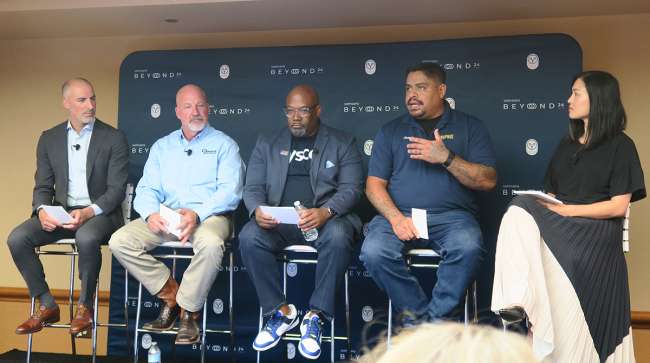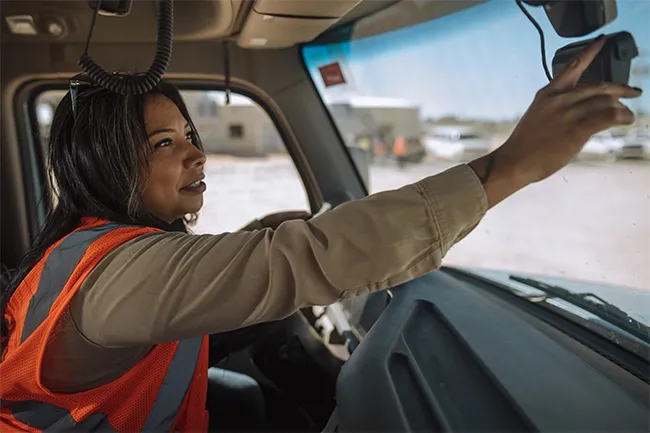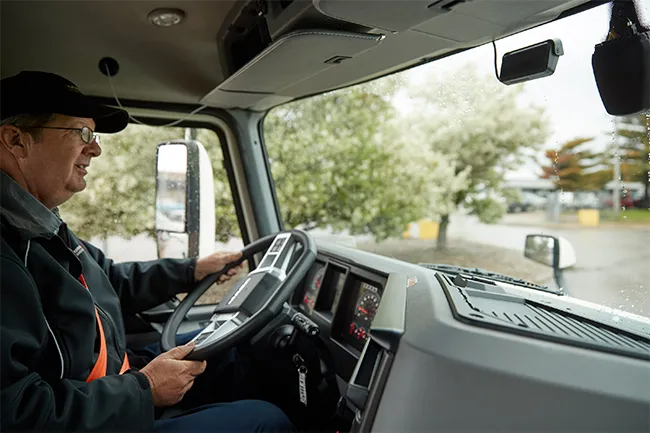Managing Editor, Features and Multimedia
Gaining Driver Buy-In Is Key to Deploying Dashcams

[Stay on top of transportation news: Get TTNews in your inbox.]
CHICAGO — Fleet operators are increasingly embracing the use of dash cameras to elevate their safety programs, prevent crashes and reduce risk, but successfully deploying these in-cab systems hinges on driver acceptance of the technology.
For a smoother rollout, motor carriers should clearly communicate how and why they are using the cameras and include their drivers in an open dialogue while introducing them, fleet managers and other industry experts advised.
“Communicating early is key to rolling out dashcams,” Scott Amox, safety engineer manager at Glazer’s Beer and Beverage, said during a panel discussion at Samsara’s 2024 Beyond conference, held June 26-28.
When Glazer’s Beer and Beverage began introducing cameras in its private fleet, the beverage distributor allowed its drivers to experience the technology firsthand and showed them the type of footage that the forward- and inward-facing cameras were capturing.

Drivers tend to be more accepting of in-cab cameras after having a chance to experience the technology firsthand, industry experts said. (Samsara)
“Most drivers, you’ll find, don’t understand what the camera is and exactly what the camera is doing,” Amox said. “Once you educate them from the very beginning, it is much, much easier to get them in the boat with you.”
Even so, fleets can expect to experience some pushback from drivers when introducing cameras.
“In the beginning, you’re always going to encounter that resistance,” Amox said. “It doesn’t matter what you change. With change, comes resistance.”
Although drivers often voice concerns about privacy when companies install in-cab cameras, that opposition tends to fade over time as drivers realize that dashcams can protect them from false claims and help ensure that they go home safely to their families at the end of their shift.
Employee engagement is crucial for overcoming the misconception that dashcams are in the vehicle to watch drivers’ every move, said Kevin Thomas, vice president of global environmental, health, safety, security and asset protection at food service distributor Sysco Corp.
He said fleets should give drivers ample opportunity to provide feedback and listen to their concerns while introducing cameras.
One of the most powerful ways to gain authentic buy-in from drivers is to highlight cases where onboard video exonerated a driver who was not at fault in a crash.
For Sysco, a high-profile incident involving one of its drivers recently demonstrated the value of in-cab cameras. In March, a Sysco driver was rescued from a tractor-trailer dangling off the edge of a bridge in Louisville, Ky., in a harrowing event that captured national and international attention.

Driver opposition tends to fade as drivers realize that dashcams can protect them from false claims and help ensure that they go home safely. (Samsara)
A Samsara dashcam installed in the truck showed that the incident was caused by a passenger vehicle that swerved into the Sysco truck’s lane and struck it head on, forcing the truck over the edge of the bridge.
That video not only provided clarity on what happened but also immediately exonerated Sysco’s driver, Thomas said.
“She was doing everything she was trained and taught to do,” he said.
Houston-based Sysco ranks No. 3 on the Transport Topics Top 100 list of the largest private carriers in North America, and No. 1 on the top food service carriers list.
Jesus Davila, a professional driver for Werner Enterprises who has accumulated more than 650,000 safe miles, shared his perspective on in-cab technology rollouts.
Jeff Loftus of FMCSA joins TT’s Seth Clevenger to discuss the current outlook on ADAS technology and how it will affect the industry at large. Tune in above or by going to RoadSigns.ttnews.com.
Davila, who also serves as a driver leader at Werner and an America’s Road Team Captain for American Trucking Associations, said fleet safety managers should clearly explain the reasons for installing dashcams and remember that the truck is the driver’s apartment while they’re out on the road.
When Werner installed cameras in its trucks, the company’s executives and driver leaders emphasized that the purpose of the technology is not to constantly watch drivers, but to protect the company from incidents where its drivers are not at fault while also providing feedback and day-to-day tips to help drivers become safer.
“Use it as a tool and not something negative,” Davila said.
Werner, based in Omaha, Neb., ranks No. 16 on TT’s Top 100 list of North America’s largest for-hire carriers.
Amox of Glazer’s Beer and Beverage said in-cab cameras also can boost company profits by preventing lawsuits that might have moved forward without video evidence. As a result, fleet operators can then afford to increase driver pay and offer more bonus opportunities, he said.
Glazer’s Beer and Beverage has a driver incentive program that provides additional compensation based on safety scores and other performance metrics.
“This is a sticks-and-carrots game. If you use just the sticks, you’re going to lose,” Amox said. “Have a system in place also that rewards those that are putting forth the effort and those that are stepping up and going above and beyond.”
Initially there can be a lot of resistance to cameras, but drivers tend to be more accepting of the technology after gaining firsthand experience with it, said Peter Goldwasser, executive director of Together for Safer Roads, a global nongovernmental organization focused on safety.
Based on a survey of more than 500 drivers, the group found that 70% of drivers said in-cab technology is acceptable after proper change management.
“Drivers trust personal experience,” Goldwasser said. “The biggest thing we found after the interviews was that comfort increased with familiarity.”
The survey also found that one out of five drivers had been exonerated by video and a quarter of them recalled avoiding crashes with the help of the technology, he said.
Want more news? Listen to today's daily briefing above or go here for more info
“When you begin to explain why you have these cameras, what the purpose is, how it can be helpful, how it can exonerate, how it can help train, you begin to see dramatic increases in acceptability,” Goldwasser said.
Across the board, the panelists emphasized the importance of communicating with drivers proactively when implementing dashcams and allowing them to offer their perspectives and ask questions.
“That is a fundamental best practice,” Goldwasser said.
The biggest problems arise, he said, when drivers show up to work and see that the technology is in the cab without an explanation.
Fleets should also ensure that in-cab technology deployments tie in with their companies’ broader safety programs and culture, panelists said.
When introducing new technology, fleet safety managers should embrace their responsibility to protect their drivers and always look for ways to “connect to their hearts, their minds and their pockets,” Sysco’s Thomas said. “That’s a recipe that works.”



